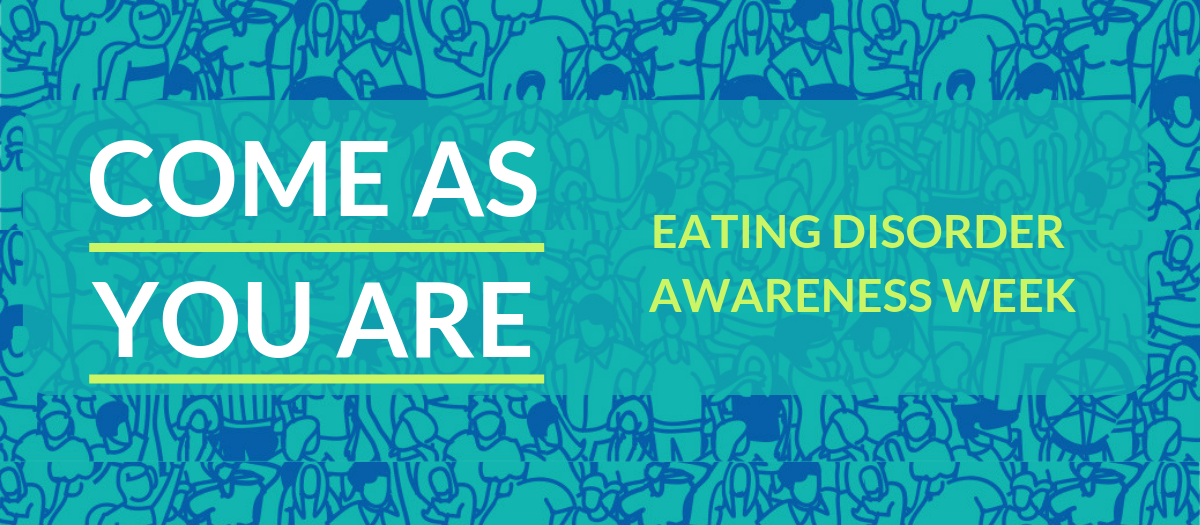Common Myths of Eating Disorders
Hi Friends!
This week is National Eating Disorder Awareness week!

This week means bringing awareness to eating disorders-disordered eating, especially in a pandemic! We have been getting through this pandemic and some of us have had more struggles than others due to the rise in mental health related concerns. Here is a reminder of what eating disorders are defined by “disorders of eating behaviors that develop to deal with problems in a variety of areas of life, including self-esteem, emotional regulation, fears of growing up, and relationship conflicts, etc. as methods to deal with these issues.” Disordered eating is “used as a descriptive phrase to describe a range of irregular eating behaviors that may or may not warrant a diagnosis of a specific eating disorder.” The topic of eating disorders is breaking out of its taboo shell and allowing others to finally talk about the topic without shame. Suffering in silence should be a thing of the past!
I wanted to bust three myths about eating disorders that should also be a thing of the past!
-Myth 1: you can tell when someone has an eating disorder by their appearance
-Myth 2: A person with an eating disorder can just go “fix” themselves and then come back and live a normal life.
-Myth 3: Eating disorders are a “girl thing”.
Yikes! To be quite honest, I have actually heard all three of these used by people discussing eating disorders. If you, parent, coach, teacher, loved one, don’t understand eating disorders, THAT IS OKAY. You don’t need to be the expert on helping the person on the eating disorder journey. You only need to be a support system. The process may be frustrating, challenging, heart wrenching, and leave you feeling helpless. Please note there are several great resources out there to help guide you on this journey as well. Do not suffer in silence or let your loved one suffer in lack of support.

Let's myth bust!
Myth #1: You can tell when someone has an eating disorder by their appearance.
WRONG.
The belief behind this myth stems from what media would say as the most popular eating disorder: anorexia. Anorexia is often the eating disorder that is “seen” due to the symptom of severe underweight or appearing to look like a skeleton. Looking at a “skinny” person does not guarantee diagnosis of an eating disorder and/or if she or he is in a healthy weight range. I will admit seeing a person that is severely underweight is alarming and should trigger anyone to have concern. Diet culture, social media, and television shows have fed us what anorexia looks like based on the body size represented in the pictures they want us to see.
What if I told you that majority of those living with eating disorders, including anorexia, live in what appears to be a relative healthy body weight range. GASP, there are more eating disorders than just anorexia?! Eating disorders such as bulimia, binge eating disorder, avoidant restrictive food intake disorder, orthorexia and eating disorder not otherwise specified, are more commonly seen in what you would call a “normal weight” and go unnoticed by others. It is how the eating disorder takes control, it goes undetected. Eating disorders don’t want the lime light, they want control. Judging someone off their appearance of being underweight could also be due to a variety of reasons or this person could be…..healthy. Next time you “see” someone that appears to have an eating disorder, ask yourself how many times you thought that when you saw someone at what appears to be a “healthy” weight.
Myth 2: A person with an eating disorder can just go “fix” themselves and then come back and live a normal life.
FACE PALM.
The action of going to “fix” oneself from an eating disorder is like breaking a bone and all you need is some time in a cast. Maybe insert screw here and here to hold the bone together and all fixed. This myth is fueled by knowing there are treatment centers out there people can do to and automatically thinking once you’re done with treatment you are “cured”. I can understand this thought- it’s like going to AA, graduating, and then never relapsing. Easier said than done.
Consider this: what if the eating disorder is their way of controlling their environment or dealing with hardship.
Again, eating disorders are disorders of eating behavior. The behavior(s) develop to deal with problems arising in life. These behaviors typically have nothing to do with food, only strategies to deal with problems that arise whether it be social, emotional, fears, etc. Here’s a visual: you get a flat tire, you take it to the shop to get fix, and the next thing you know another tire is flat. You think “I just got this fixed.” Instead of continuously taking it to the shop to get fixed, you research the tools you need to deal with the problem when it arises. No more taking it to the shop because you have all the tools you need. Same with “fixing” an eating disorder- provide the individual with the tools he or she needs to go through the journey of recovery, which can last a lifetime.
Myth 3: Eating disorders are what girls do.
HUH?
I hate to admit but I can see the myth in this because for years eating disorders have been seen in majority of upper class white women. Society has been fueling this myth. Again, society, diet culture, media, social class, etc perpetuate the stigma of women falling victim to eating disorders. Although, it isn’t exactly false, it just isn’t the whole truth. Eating disorders do happen in this population, as they do in lower socioeconomical individuals and….
What if I told you men also experience eating disorders?! Mind blown. Men make up approximately 25% of those with anorexia and use subclinical eating disorders behaviors as often as women do. For example, binging, purging, fasting for weight loss, etc. Eating disorders in men have actually rose in the athletic environment as well; however, men typically do not report the struggles they are going through due to appearing to be “weak”, “not masculine,” or because “it’s what girls do.” Eating disorders do not discriminate against men, women, social class, body size, or any other dividing factor. Eating disorders are a mental illness.
Do not suffer in silence. Seek support. Share the voices in your head. Stay strong, the journey to recovery can be a long one except it’s worth it.
Become aware this week- get familiar with the facts and become an ally for others.



